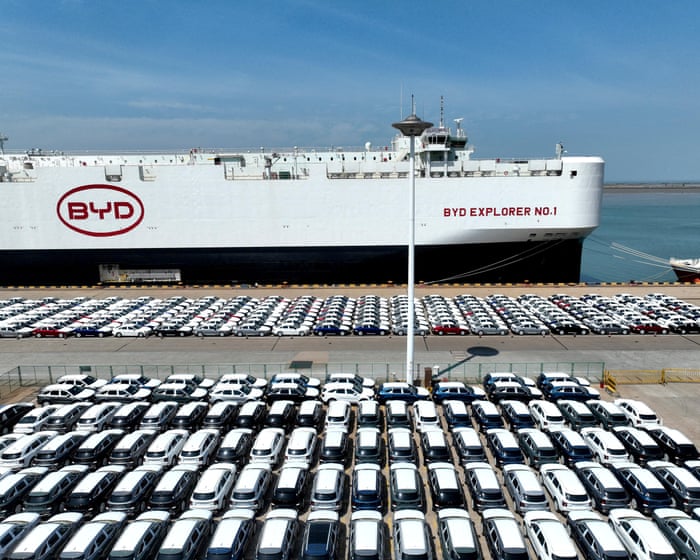Franck Detcheverry, the 41-year-old mayor of Miquelon, makes his way up a grassy slope. “The view isn’t too bad, huh?” he quips. Below the empty hill, the ocean glitters just 40 meters down. From the shore, the sound of a man playing the bagpipes drifts up, as if serenading the sea. This hill will soon be the site of his new home and those of all his fellow villagers.
In the distance, about half a mile away, the outline of Miquelon village’s roughly 400 buildings is visible. The village sits just 2 meters above sea level on the Saint-Pierre and Miquelon archipelago. Located off the Canadian coast south of Newfoundland, it is a French overseas territory and France’s last remaining foothold in North America.
Franck Detcheverry stands at the future site of the new village. “We all know each other. That’s why it’s hard to carry out a project like this,” the mayor remarks.
This is the kind of place where people leave their car doors unlocked while picking up groceries at the general store, and everyone greets you with a “bonjour” as they pass by on the street.
“But just over a decade ago, something happened that would forever change the island’s future,” Detcheverry continues. “We negotiated with the government to give us three years to build our new homes… we’re doing it little by little.”
In 2014, François Hollande became the first French head of state to visit Miquelon—and he delivered devastating news to its approximately 600 residents: Miquelon could soon disappear due to rising sea levels, projected to reach one meter by the century’s end. Consequently, he placed the village under a coastal risk-prevention plan that banned all new construction.
The announcement shocked the villagers. “For a village this small, it meant there was no future,” says Xénia Philippenko, a geographer who began her graduate studies on Miquelon’s relocation right after Hollande’s declaration.
When she returned to the village just months later, Philippenko noticed a shift in attitudes. Two consecutive storms had flooded homes and damaged property. It seemed people were beginning to accept they would have to move and took to the streets demanding a plan.
However, it wasn’t until 2022 that the local government, led by Detcheverry, seriously began considering relocation after the village narrowly escaped Hurricane Fiona, one of Canada’s costliest weather events.
Once completed, the move will make Miquelon the first French village to relocate due to the climate emergency. The French government is investing public funds through an unprecedented use of the Barnier fund, which supports citizens whose homes are threatened by the climate crisis by repurchasing their properties.
“Usually, you have to leave your house immediately after the government buys it,” Detcheverry explains. “We negotiated to give residents three years to build their new homes. We’re proceeding gradually, with about seven to eight houses each year.”
For now, relocation is voluntary, and nearly 50 people have signed up to move. Last month, nine individuals signed leases and received construction permits. Meanwhile, workers began extending Miquelon’s water and electricity supplies to the new site.
The goal is to maintain connectivity between the two locations as people move across the bridge separating them. As long as most villagers remain in the old village, the town hall, school, and other essential services will stay there.Other public buildings will remain in place, and the new village will include a storm shelter.
A satellite image reveals the delicate isthmus that connects the main islands of Saint-Pierre and Miquelon. Phillippe Detcheverry, a retired utility executive (no relation to the mayor), is among the first to relocate. He built his house himself four decades ago, like many in Miquelon, but found parting with it easier than expected. After enduring multiple floods with his wife, they viewed the move as a chance for a fresh start and have already designed their new home.
“The restriction on building here, coupled with the uncertainty of being safe from the sea as storms grow stronger and more frequent, made us realize our property here isn’t worth much anymore,” he explains. He adds that discussing his relocation with some friends leads to heated arguments.
“And what will we leave for our children?” he asks. For Detcheverry, moving is an investment in his two sons’ future. “Otherwise, we’d just be leaving behind a building.”
The ocean is a constant presence in Miquelon, visible from nearly everywhere and shaping daily life—determining when supplies arrive by ship or if someone can reach a doctor’s appointment on Saint-Pierre. It was the sea’s abundance that originally drew people here.
Many residents are descendants of Acadians, French settlers from the 17th century who established a colony in what is now Canada’s Maritime provinces. They came centuries ago to fish for cod but were displaced multiple times as control of the archipelago shifted between British and French rule. Each time, the Acadians returned—suggesting that moving is ingrained in the villagers’ history.
Now, rising sea levels and more intense storms are eroding the sandy isthmus linking the largest islands. The cod fishery collapsed in the early 1990s, leading Canada to impose a fishing moratorium in 1992. While Saint-Pierre has attempted to diversify through tourism and construction jobs, it faces economic challenges, and Miquelon’s economy never bounced back.
The sense of loss over the fishery remains strong. “We always find a way to talk about the loss of fishing,” says Detcheverry. “But we need to start working towards something new.”
Supporters of the relocation project see it as a potential catalyst for change, especially as the archipelago grapples with an aging population. Without a university, many young people leave for mainland France or Canada to study and seldom return.
Nancy Hayes remains hopeful. She juggles multiple roles in the village, from organizing the annual 25km race to handling customs and volunteering with the local football team. “I’m optimistic and positive,” Hayes says, “because otherwise we’d just be watching the water rise.”
Working at the mayor’s office, she notices growing interest in relocation among residents. Hayes believes that offering young people the chance to build homes might encourage some to come back.
However, not everyone supports the move. Detcheverry notes that conversations with certain friends about his relocation plans often turn contentious.The mayor’s office is seeing more interest in relocation, but believes it might take another Hurricane Fiona to convince some residents. Photograph: Sara Hashemi
Although the signs of the climate crisis are clear on the island—the ocean is slowly eroding the isthmus that connects its parts—many feel they have more time. Miquelon hasn’t experienced storms as severe as those that sparked the project years ago. “It’s difficult to say, but it might take another Hurricane Fiona to change people’s minds,” says Hayes.
The small-town nature of the community also poses challenges. “We’re all more or less cousins,” says Franck Detcheverry. “We all know each other. That’s why it’s hard to carry out a project like this.”
Bernard Briand, president of Saint-Pierre and Miquelon, is among the skeptics. While the territorial council provided the land Miquelon wanted and supports the mayor’s relocation project, he doubts their efforts will succeed. He believes more should be done to preserve the village as it is. “When you step on Miquelon, you feel its history, its soul,” he says. “How do you recreate a soul?”
That’s a question Laurent Pinon and his colleagues at the urban architectural agency working on the relocation have also wrestled with. “The project reflects Miquelon’s history,” he explains. Residents can build their own houses, a long-standing tradition in the village, and many materials for the new village will be repurposed from the current one.
A composite image shows a row of brightly painted single-story wooden houses and, on the right, the rusted bow of a boat with a painted anchor. Traditional houses on Miquelon. The islands’ economy never recovered from the collapse of the cod fishery in the 1990s. Photographs: Mathieu Dupuis/Legendary Coasts of Eastern Newfoundland
“We’re taking everything that exists—the inhabitants, their homes, their geography—and reorganizing it to create a new village that allows them to continue living there.”
The immediate priority is ensuring residents’ safety. Deciding what to do with the local church, cemetery, and other historic sites will likely involve difficult discussions, but relocating people must come first.
Although construction is now underway, there’s still a chance things could revert. Local elections in the new year may bring a government that doesn’t continue the relocation.
“That’s the hope,” the mayor says. “With the [prevention plan] and climate change, Miquelon was doomed. It would have disappeared. I want to give my village a future.”
Frequently Asked Questions
Of course Here is a list of FAQs about relocating a village inspired by the situation in Frances final North American territory SaintPierre and Miquelon
Beginner General Questions
1 Why would an entire village need to be relocated
The primary reason is climate change Rising sea levels coastal erosion and increasingly powerful storms are causing the shoreline to disappear making it unsafe for people to live in their current homes
2 Where is Frances final North American territory
Its the archipelago of SaintPierre and Miquelon located just off the coast of Newfoundland Canada
3 What does relocating a village actually mean
It means moving all the people their homes critical infrastructure and community buildings to a new safer location further inland
4 Who decides to move a village
Its typically a joint decision The local community and its leaders must agree and they work with regional and national governments to plan and fund the massive project
5 Isnt it easier to just build sea walls
While sea walls can help in the short term they are often very expensive and not a permanent solution against the relentless force of the ocean and rising sea levels Relocation is considered a more definitive longterm answer
Process Practicality Questions
6 Whats the first step in relocating a village
The first step is a detailed risk assessment and extensive community consultation Everyone needs to be on board and understand the necessity and the plan
7 How do you choose a new location for the village
Experts identify land that is elevated stable and not prone to flooding It also needs to be large enough and have access to resources
8 Who pays for something this huge
Relocation is extremely expensive The funding usually comes from a combination of sources the national government regional grants and sometimes international climate adaptation funds
9 What happens to peoples old homes
This is a difficult part Often the old homes in the danger zone are demolished after everyone has moved out This prevents people from moving back into a hazardous area and allows the land to return to nature




